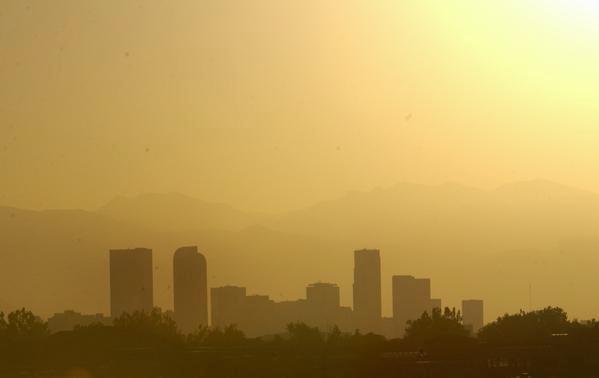While scientists collect data, run simulations and produce expert knowledge about tropospheric ozone, policy makers are the ones to draft regulations that impact how citizens interact with tropospheric ozone. During our research looking into the social aspects of ozone pollution in the Front Range, we quickly learned the immense role air quality regulations have in protecting local vegetation and our health.
Regulations that constitute an ozone alert are largely determined by the Environmental Protection Agency (EPA). In regards to tropospheric ozone, the EPA sets air quality standards that all States are responsible to maintain. Under the Clean Air Act, the EPA sets National Ambient Air Quality Standards (commonly referred to as NAAQS). Ozone is one of six common air pollutants the EPA monitors and mitigates through air quality standards. As a result of NAAQS, the EPA also determines what areas qualify as “nonattainment”–meaning the ozone levels in that area exceeds air quality standards set by the EPA. For nonattainment areas, the state must draft a State Implementation Plan to improve the air quality of the area. Failure to meet these standards often calls for EPA involvement.
The Front Range area in Colorado has notoriously high tropospheric ozone levels. In December 2019, the Denver Metro/Northern Front Range area was reclassified as a serious nonattainment area for ozone, as the state of Colorado failed to meet safe ozone standards in a timely manner. The ubiquitous presence of tropospheric ozone within the Front Range is damaging to human health and vegetation in the area.
The Front Range has some of the highest concentrations of ozone pollution in the U.S.

To better understand the policy surrounding an ozone alert and regulations, we interviewed two attorneys. One represented the EPA and another from a non-profit environmental advocacy group. With these lawyers, we discussed their work and the involvement of scientific expertise in policy production. The science that helps inform standards set by the EPA often comes from technical experts. One of our collaborators at NOAA explained that as scientists, research results are shared through peer reviewed literature. “The key points from these papers then make their way to policy-makers through summary reports that are produced by the EPA or other experts…Sometimes we are involved with the drafting or review of these summary reports, but most of the time we are not.” When a paper is newsworthy and picked up by the press, “policymakers become aware of the results a lot sooner.” While NOAA’s research is not aimed at influencing policy, their work can be important in determining appropriate air quality standards.
In drafting regulations, the EPA relies on collaboration between lawyers, policy makers and scientists to collect and interpret data. Regulations are often written by technical experts with oversight from attorneys, who help ensure that nontechnical citizens can understand the regulation. The EPA is then responsible for upholding and implementing these regulations.
Communication teams are important in relaying regulations to the public in a way that makes sense to groups outside the science community, including policy makers involved in drafting regulations. Lawyers help ensure that the regulation makes sense, and can act as a linguistic filter between technical experts and the public.
Unlike the EPA lawyer we interviewed, the non-Profit organization attorney we spoke with actively seeks areas within laws and regulations to further environmental conservation, specifically in regards to air and water quality. Similar to the EPA lawyer, the non-profit attorney we interviewed pointed out that laws work within thresholds, and noted that the general public is mainly concerned with how a law affects them personally.
We discovered that scientists are often bound by their research findings. While the EPA lawyer noted that although a scientist may see one path as the best, the attorney representing the non-profit environmental group pointed out that many scientists are only comfortable speaking out about what their research proves. Scientists present evidence, and might be uncomfortable to make inferences or go beyond their research findings. We noticed similar comments from a scientists that studies ozone impact on vegetation. But as this attorney pointed out, sometimes you don’t need to see every detail of a picture to know it’s a grim one. In fact, policymakers often claim a lack of scientific evidence as a way to slow down legislation. The increasing commonality of harsh critique and backlash against scientific expertise, especially with environmental science, could attribute to scientists unease to speak beyond the quantifiable findings of their research.
Policymakers often claim a lack of scientific evidence as a way to slow down legislation.
Most environmental regulations in the U.S are based on older legislation, showcasing the slow advancement of environmental action within congress. Current legislative efforts to mitigate tropospheric ozone pollution are continually denied. Especially in the wake of the COVID-19, epidemic, environmental legislative actions have been pushed to the way side.
From our conversations, it is easy to see how an individual’s relationship to policy is heavily dependent on the organization they represent. While the attorney from the non-profit organization we spoke with does work that aligns with their identity as an environmentalist, the EPA attorney discussed having to remain apolitical in regards to environmental policy.
As anthropology students, going into this project we had little knowledge of ozone science. Throughout the project we had to familiarize ourselves with not just with the science around ozone pollution, but also the policies that regulate tropospheric ozone across the state. In our conversations we saw collaboration between different parties, organizations, professions and a combination of private and government interests. The collaboration between these facets is essential in producing effective policy. Understanding the different yet interconnected roles that all attribute to the generation of ozone policy, is key to identify opportunities of legislative change that account for human and vegetative health in the Front Range.
